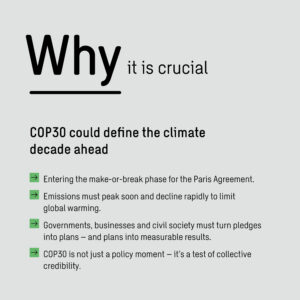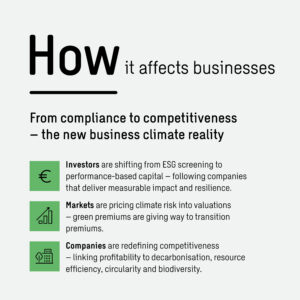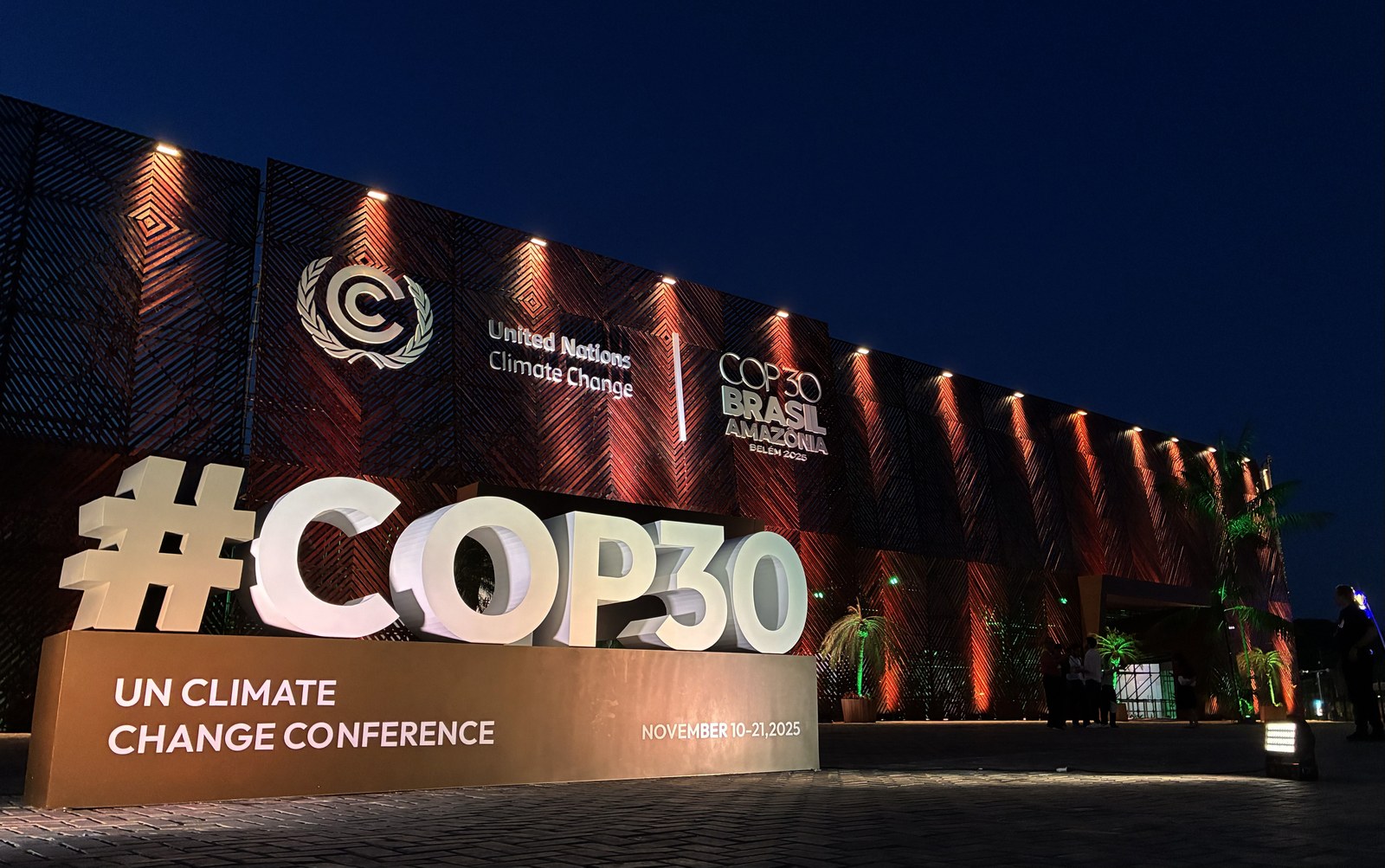Can COP30 define the climate decade ahead?
Published on: November 7, 2025
On 10 – 21 November 2025, climate policy makers, scientists, civil society, journalists and the business sector all gather for two weeks in Belém, Brazil, for the 30th UN Climate Convention – COP30. Andreas Gyllenhammar, Chief Sustainability Officer at Sweco, dives into the expectations and analyses the setting of the summit.
The 30th UN Climate Convention promises to be a very interesting one indeed. The tables are filled with critical issues to be resolved, and the world is looking for answers, or at least clues to the following questions:
- What new emissions reductions can we expect from the signatories of the Paris Agreement? And how to tackle the gaps between what is promised and what is needed?
- How should we measure and monitor progress on climate adaptation?
- Can we fill the gaps in promised and needed climate finance in order to build trust between nations and advance negotiations?
- Will the logistics in Belém hold up to support the expected 50,000 people?
The short-term analysis can be done in just over two weeks. Did we fail or succeed and what will be the consequences? And, except for COP21 in Paris, the results usually lean towards the disappointing side. But, in my experience, a more interesting analysis is visible when we look beyond the media headlines and dive deeper into signals and more long-term trends that build up over the years.
Background
I’ve been a regular COP attendee since 2009 as a representative of the international business community. As Chief Sustainability Officer of Sweco, a long standing member of the WBCSD and being a climate analyst, I’ve been part of the BINGO (Business Industry Non Governmental Organisation) observer group. We have access to the negotiation rooms, can follow the progress and make statements on behalf of the business community. Equally important is that we take part in the extensive side-event arena of the COP where climate matters are discussed, best practices are shared and different stakeholders exchange ideas, knowledge and experiences. For Sweco, it’s important to participate, analyse effects of outcomes and to contribute with our collective competence on climate transition and adaptation.
COP30 – Important and complex
The climate issue has both gone broader and deeper during the years. At first, it was about emission reductions, then we added climate adaptation and now the topics of loss and damage and a just transition has completed the picture. This has called for a reform of the progress since it is almost impossible to manage and negotiate such a huge number of complex matters. Climate investor, activist and former US Vice President Al Gore, has also been trying to rally up support for a change of the consensus rule with the argument that it slows down the processes and allows for single opposing nations with low ambition to halt or reverse progress. True indeed, but this is maybe a fight that not even Al Gore can win. The importance of the COP might even be bigger this year with so much turbulence on many levels. There are plenty of eyes on the meeting looking for signs of global leadership and for certainty on where we all are heading. A future with focus on the green transition, investing in clean economies? Or are we rapidly moving towards a warmer world with heavy climate effects on humans and societies?
Truly turbulent climate times
The delegates will gather after a truly turbulent year in global development. Multiple crises, increasing nationalism, rising conflicts and quite many steps away from the world order we knew – where international cooperation has been the norm back since the aftermath of World War II. The US has applied for leaving the Paris Agreement and the exit will be ratified in January 2026. So, formally still being a signatory there’s been a lot of uncertainty whether they would still show up for the COP30. We just recently received notice that the US will not send a formal negotiating delegation. However, the US will be well represented through progressive states, cities and businesses that have high stakes in climate matters.
2025 has also been a year of climate progress. Maybe not always headlining the news and not always from the usual suspects. Among the more significant to me being the rapid development in Asia. China seems to just have peaked their carbon emissions, long before they promised to do so and driven by rapid deployment of renewable energy and electrified transportation. India is also showing great progress. After COVID, the rise in emissions have been ca 10% annually, and but during the last 12 months they are down to 1-2%. The peak emissions are just round the corner.
It can all be summarized into this: There is a need for raised ambition and speed to close the emission and finance gaps. But progress is happening.
What will be on the agenda at COP30?
Many people do not know that the agenda of a COP is in fact decided at the beginning of the meeting. Of course, a lot of issues are prepared and expected to show up but there’s usually also some fighting over what to include and what not to. One of the items there will be a fight for to include is to discuss what to do with the gap that we now know exists between the new NDCs and what is needed to reach the Paris agreement goals.
The hosting country also gets to have their saying during the preparations for the COP and this year we can expect to see the meeting getting influence from its rainforest setting. Expect to see deforestation, just transition and climate finance being addressed.
The President of the COP is also influential, not only on the agenda but he/she is also crucial in navigating the negotiations throughout the two weeks. You want to look out for diplomatic skills and endurance during the last meeting days when things get hot, and all delegates are getting increasingly exhausted. This year, it is Corrêa do Lago, a well experienced Brazilian minister and diplomat with meetings such as the monumental Earth Summit in Rio 1992 on his CV. His priorities leading up to the COP has been to establish COP30 as going from words to action. An implementation COP (which we have heard for previous COPs). He has also emphasized the need to create leverage outside of the UNFCCC and to work with ”mutirão”, which is a Brazilian expression for creating a global and scalable movement with local actions.
Top issues we can expect to be discussed and negotiated
New emissions reductions plans and how to raise ambitions
This is the COP for parties to come in with new climate promises. According to the Paris Agreement in 2015, this is to be done every five years and this is the second time they are revised. Is has proven to be very tough and only 70 countries fulfilled this promise for the deadline. However, many are expected to bring them to the meeting (China, India etc) and EU just finished negotiating their new NDC. Since the analysis is clear, there is too little action, too late, we could expect COP30 to discuss an “ambition mechanism” to address the reduction gap. An output could be an “ambition framework” clarifying how to increase the speed in the green transition.
New quantified goals for climate adaptation
The more we delay necessary mitigation action, the more we need to figure out how to work with climate adaptation. This year’s COP is set to produce metrics on how to compare progress with national adaptation plans. It’s been a tedious preparative work with a starting list of 9,000 proposed targets. It has been reduced to 500 and the goal for COP30 is to come out with a list of 100 key metrics.
The ”pivotal Paris point”
Who’s going to pay, and how much? This has always been a corner stone of the negotiations and is an essential question to solve. This is also the biggest trust issue that always threatens to wreck negotiations if not handled in a good enough manner. At COP29 in Baku it was agreed to increase finance to developing countries in a “New collective quantified goal” by tripling funding to 300B USD/year by 2035. However, developing nations demanded 1.3 trillion USD and it was promised that parties will “work together” to reach that number. Expect them to bring that up in Belém.
Reports – Incoming!
One of the more interesting aspects of all COPs is that during the months and weeks leading up to the meeting, a lot of new reports are released. From them we get an updated view on the state of climate science, policy and finance. I’ll come back to them during the weeks of COP to highlight interesting development.
Belém logistics
I’ve been to many COP meetings where the practical conditions surrounding the meeting have been challenging. This year looks to be the worst, so far. Belém has had limited accommodation capacity, and they have been forced to ready military facilities with bunk beds, use student dormitories and to summon two large cruise ships to the harbour where the prize for one night is about 1,200 USD. The place is also hot and humid and yesterday I got a message from the organizers that the expected clothing is downgraded from “formal business attire” to “smart casual”. Thank you.
I will be in Belém during the second part of the convention, and I will continue to report on the developments. You could expect to get more info on business related activities, state of negotiations and reports from interesting side events.
Stay tuned.
About the author of this article
Andreas Gyllenhammar has been attending UNFCCC COP meetings since 2009 as an observer for the business and industry group or as a part of the Swedish delegation. He is Sweco’s liaison officer for WBCSD (the World Business Council on Sustainable Development) and a renowned climate analyst, working with clients to shape climate strategies by interpret science, market shifts to identify and capture opportunities in the transition towards a fossil free future.




